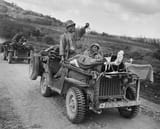Search Results
8/6/2025, 8:35:40 PM
>>64086277
They weren't great by modern standards, but amazing by the standards of WW2 which had only been over for five years when Korea started. In WW2, 4.5% of the wounded American soldiers that reached a surgical hospital still died, in Korea it was 2.5%.
Even in the well-equipped, fully-mechanized US or Commonwealth armies of WW2, casualty evacuation was often as primitive as a stretcher tied to the hood of a jeep, inching along a winding, bumpy, unpaved road, maybe with someone holding up a drip-feed of plasma if you were lucky. In REALLY rough terrain, like New Guinea or Burma, you might have to get carried all the way to the field hospital. Compared to that, a helicopter ride was practically teleportation.
They weren't great by modern standards, but amazing by the standards of WW2 which had only been over for five years when Korea started. In WW2, 4.5% of the wounded American soldiers that reached a surgical hospital still died, in Korea it was 2.5%.
Even in the well-equipped, fully-mechanized US or Commonwealth armies of WW2, casualty evacuation was often as primitive as a stretcher tied to the hood of a jeep, inching along a winding, bumpy, unpaved road, maybe with someone holding up a drip-feed of plasma if you were lucky. In REALLY rough terrain, like New Guinea or Burma, you might have to get carried all the way to the field hospital. Compared to that, a helicopter ride was practically teleportation.
Page 1
